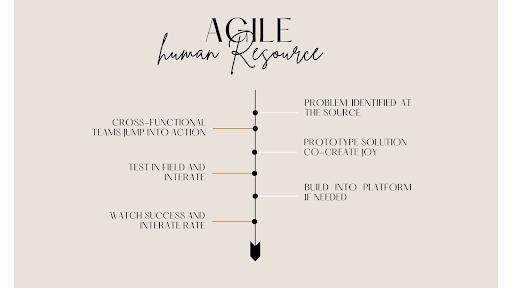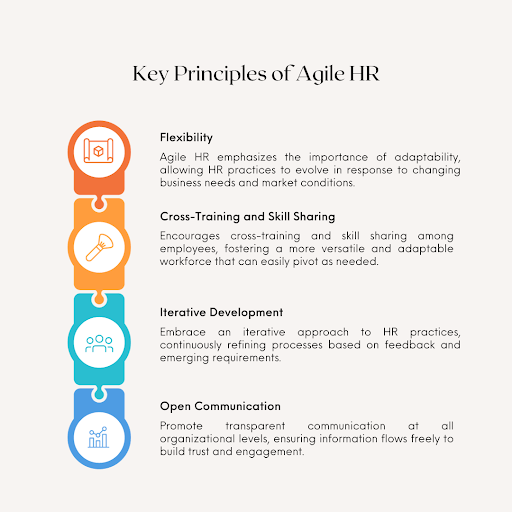In today’s fast-paced and ever-changing business landscape, the need for agility extends beyond software development into the realm of human resources. Agile HR, a paradigm shift from traditional HR practices, is gaining prominence as organizations recognize the importance of adaptability in navigating the complexities of a dynamic business environment.
Agile HR: Adapting to Change in a Dynamic Business Environment
-
January 19, 2024
- Author: Acengage Team


Understanding Agile Methodology
At its core, Agile is a set of principles and practices originally developed for software development. However, its application has transcended the tech world, finding value in various business functions, including human resources. Agile principles emphasize iterative development, collaboration, and customer feedback, providing a flexible framework that aligns well with the unpredictable nature of today’s business challenges.
“At its core, Agile is about collaboration and adaptability, and these principles are just as applicable to HR as they are to software development. It’s a mindset that helps organizations thrive in uncertainty.”
– John Smith, HR Consultant
Evolution of HR Practices
Traditional HR practices, while effective in stable environments, often struggle to keep pace with the rapid changes characteristic of the modern business world. Agile HR, on the other hand, acknowledges and embraces uncertainty, offering a more responsive and dynamic approach to people management.
Key Principles of Agile HR
Agile HR revolves around key principles such as flexibility, responsiveness, collaboration, and communication. These principles form the foundation for creating a workplace culture that encourages adaptability and continuous improvement.

Benefits of Agile HR
The adoption of Agile HR practices yields various benefits, including increased employee satisfaction and enhanced organizational performance. By fostering an environment that values transparency and open communication, Agile HR contributes to a more engaged and motivated workforce.
“Agile HR is not just about processes; it’s about people. By embracing transparency and open communication, organizations can see a 20% increase in employee satisfaction and a 15% improvement in organizational performance.” – HR Metrics Report, 2022
Tips for HR Professionals
Embracing an Agile mindset and committing to continuous learning are essential for HR professionals looking to thrive in an ever-evolving landscape. Staying informed about industry trends and proactively seeking professional development opportunities contribute to personal and organizational success.
“Continuous learning is key for HR professionals in the Agile era. Those who invest in professional development are 40% more likely to adapt successfully to changing HR landscapes.” – HR Professional Development Report, 2023
Agile HR and Employee Engagement
Agile HR plays a pivotal role in shaping a workplace culture that significantly influences employee engagement. By fostering a dynamic environment built on the principles of collaboration, innovation, and open communication, Agile HR creates conditions where employees not only thrive but also feel a deep sense of connection to their work and the organization.
Collaboration:
Agile HR encourages collaboration by breaking down traditional silos and promoting cross-functional teamwork. When employees work collaboratively on projects, they gain diverse perspectives and skills, leading to more creative and effective problem-solving. This collaborative ethos fosters a sense of community and shared purpose, contributing to higher levels of engagement.
Innovation:
In an Agile HR framework, innovation is not just welcomed but actively sought. Employees are empowered to contribute ideas and solutions, knowing that their input is valued. This emphasis on continuous improvement and a willingness to experiment cultivates a culture of innovation. Employees feel a sense of ownership over their work, driving them to explore new ideas and approaches, which is inherently motivating.
Open Communication:
Transparent and open communication is a cornerstone of Agile HR. When information flows freely throughout the organization, employees are better informed about company goals, changes, and their individual roles in achieving success. This transparency creates a sense of trust and reduces uncertainty, positively impacting employee morale and engagement.
Recognition and Appreciation:
Agile HR places a strong emphasis on recognizing and appreciating employee contributions. Regular feedback loops and performance acknowledgments become integral parts of the organizational culture. When employees feel that their efforts are seen, valued, and acknowledged, it instills a sense of pride and motivation, directly influencing their engagement levels.
Empowerment:
Agile HR empowers employees by involving them in decision-making processes. This empowerment, coupled with a trust in their capabilities, creates a more engaged workforce. When employees are given the autonomy to make decisions and contribute meaningfully to the organization, they feel a heightened sense of responsibility and purpose in their roles.
Valuing Employee Input:
Agile HR recognizes that employees are often closest to the challenges and opportunities within their roles. Seeking and valuing their input not only enhances the quality of decision-making but also demonstrates respect for their expertise. This inclusivity fosters a culture where employees feel heard and valued, contributing positively to their engagement.
Agile Leadership in HR
Leadership plays a pivotal role in driving Agile HR. Building a leadership team that understands and embraces agility is crucial for successful implementation. Leadership support ensures that the organization remains adaptive and resilient in the face of change.
Conclusion
In conclusion, Agile HR is not just a buzzword; it’s a strategic imperative for organizations navigating a dynamic business environment. Embracing Agile HR principles and practices empowers organizations to respond effectively to change, fostering a culture of continuous improvement and innovation.
